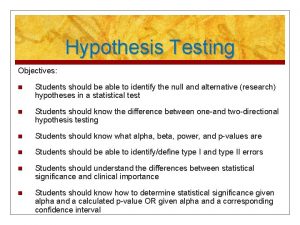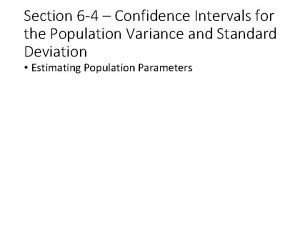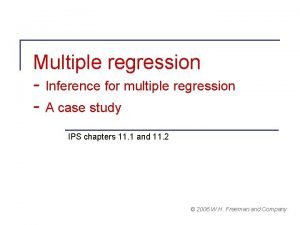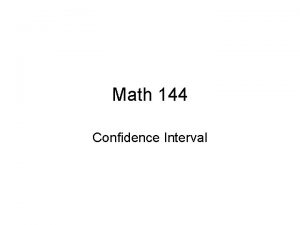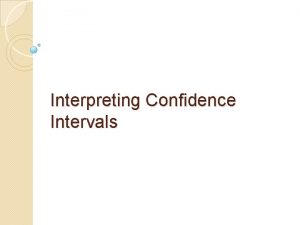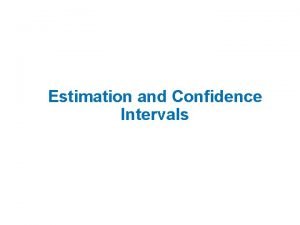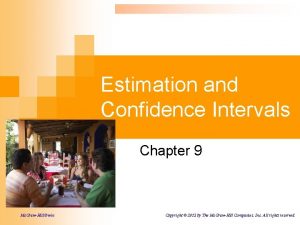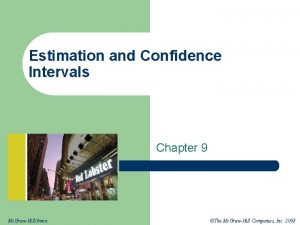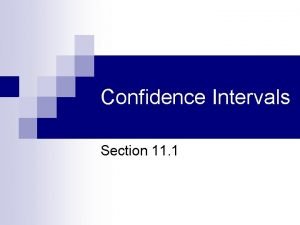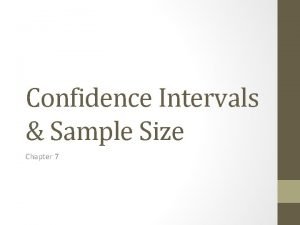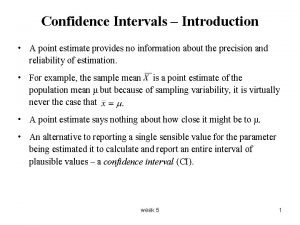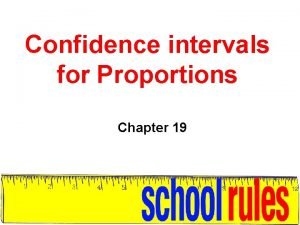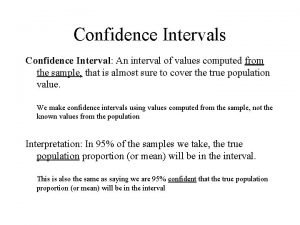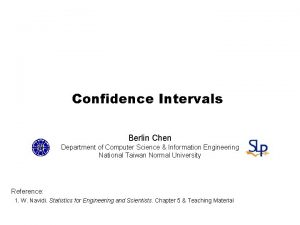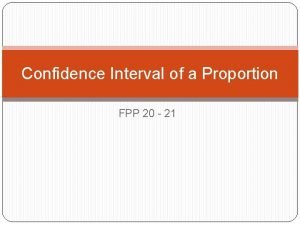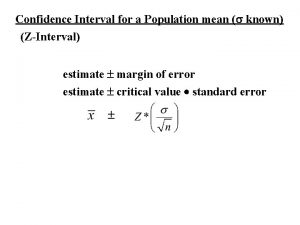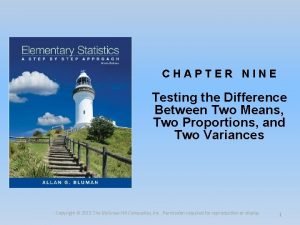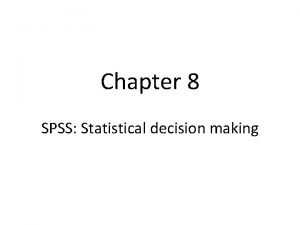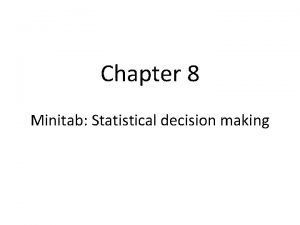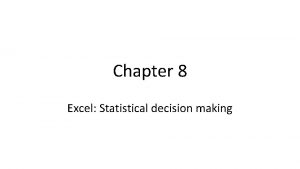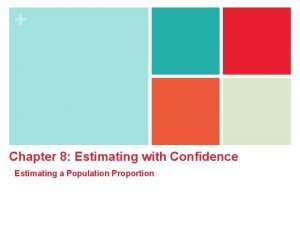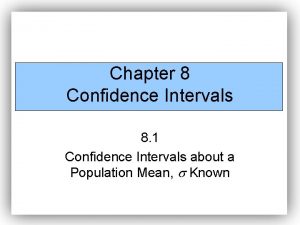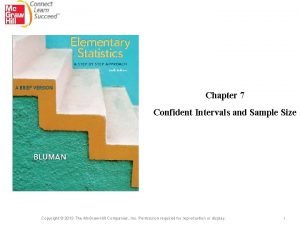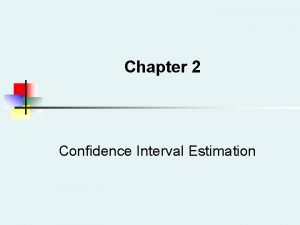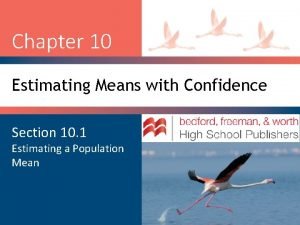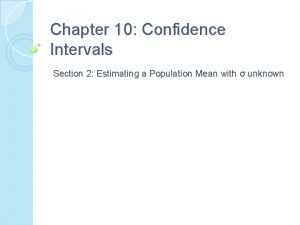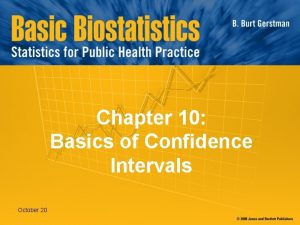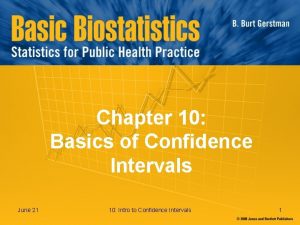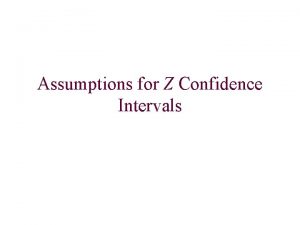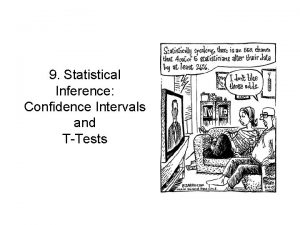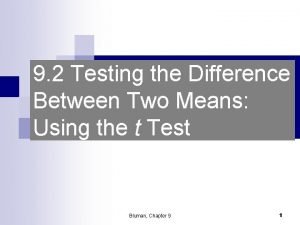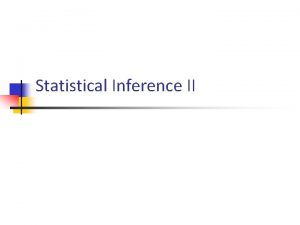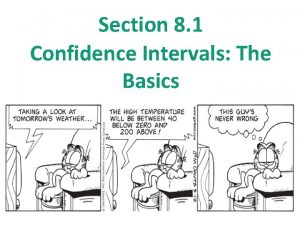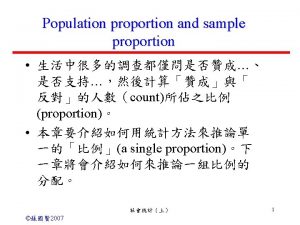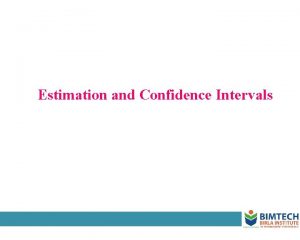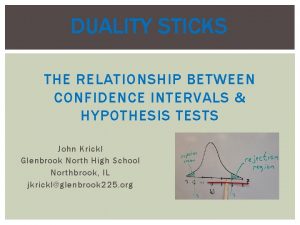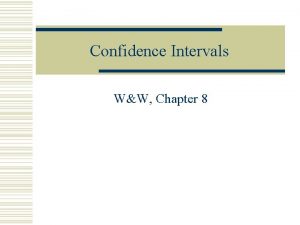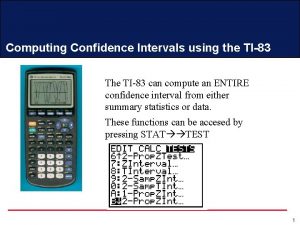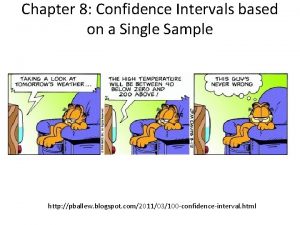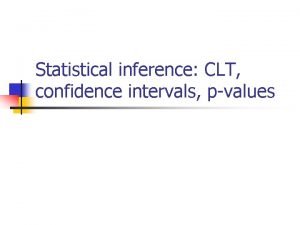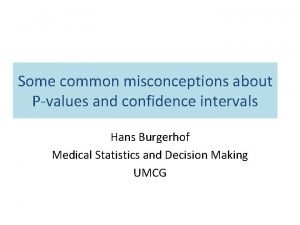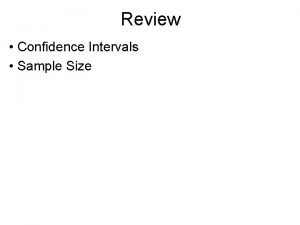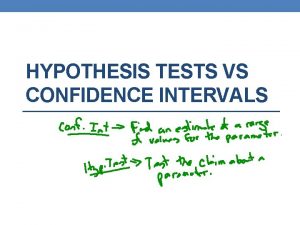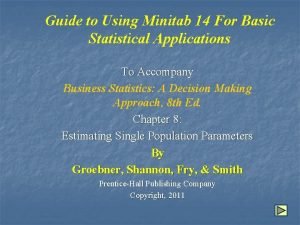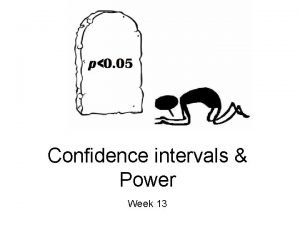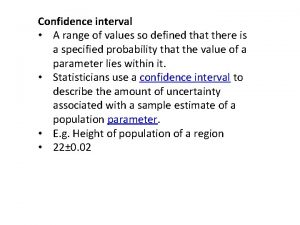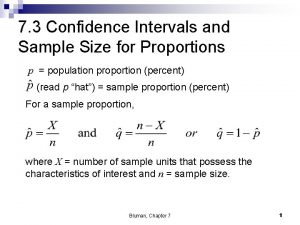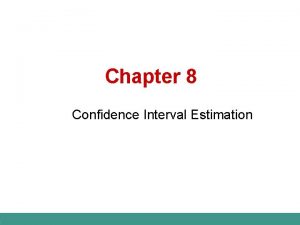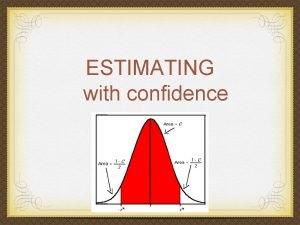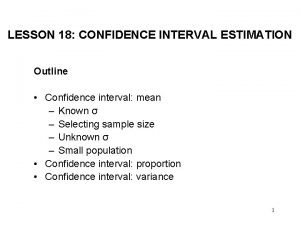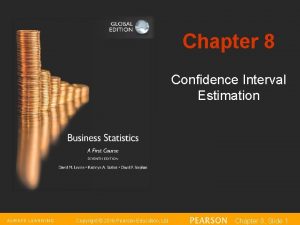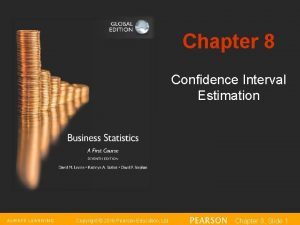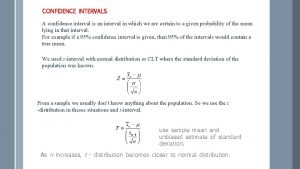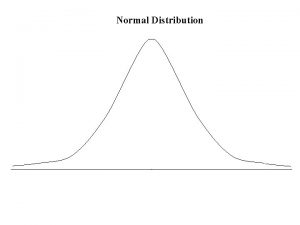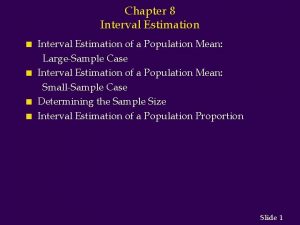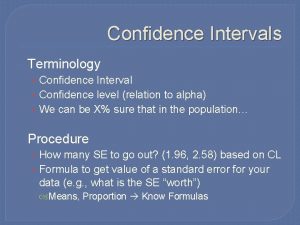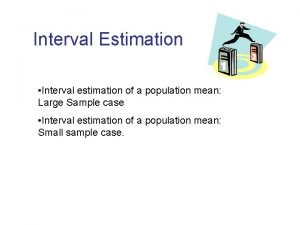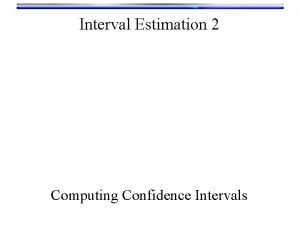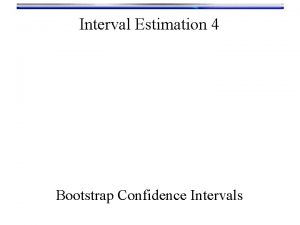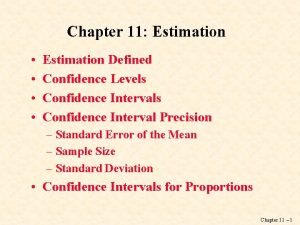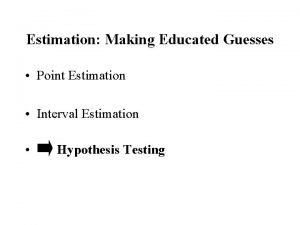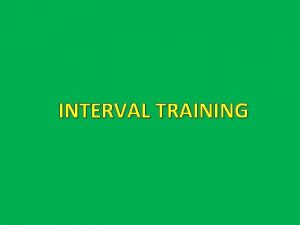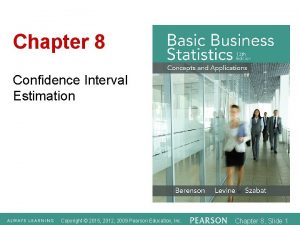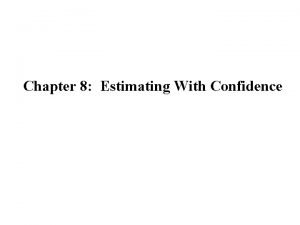Chapter 8 Confidence Interval Estimation Copyright 2016 Pearson




























































- Slides: 60

Chapter 8 Confidence Interval Estimation Copyright © 2016 Pearson Education, Ltd. Chapter 8, Slide 1

Objectives § § § In this chapter, you learn: To construct and interpret confidence interval estimates for the population mean and the population proportion To determine the sample size necessary to develop a confidence interval for the population mean or population proportion Copyright © 2016 Pearson Education, Ltd. Chapter 8, Slide 2

Chapter Outline Content of this chapter n Confidence Intervals for the Population Mean, μ n n when Population Standard Deviation σ is Known when Population Standard Deviation σ is Unknown Confidence Intervals for the Population Proportion, π Determining the Required Sample Size Copyright © 2016 Pearson Education, Ltd. Chapter 8, Slide 3

Point and Interval Estimates DCOVA n n A point estimate is a single number, a confidence interval provides additional information about the variability of the estimate Lower Confidence Limit Point Estimate Upper Confidence Limit Width of confidence interval Copyright © 2016 Pearson Education, Ltd. Chapter 8, Slide 4

Point Estimates DCOVA We can estimate a Population Parameter … with a Sample Statistic (a Point Estimate) Mean μ X Proportion π p Copyright © 2016 Pearson Education, Ltd. Chapter 8, Slide 5

Confidence Intervals DCOVA n n n How much uncertainty is associated with a point estimate of a population parameter? An interval estimate provides more information about a population characteristic than does a point estimate Such interval estimates are called confidence intervals Copyright © 2016 Pearson Education, Ltd. Chapter 8, Slide 6

Confidence Interval Estimate DCOVA n An interval gives a range of values: n n Takes into consideration variation in sample statistics from sample to sample Based on observations from 1 sample Gives information about closeness to unknown population parameters Stated in terms of level of confidence n e. g. 95% confident, 99% confident n Can never be 100% confident Copyright © 2016 Pearson Education, Ltd. Chapter 8, Slide 7

Confidence Interval Example DCOVA Cereal fill example n Population has µ = 368 and σ = 15. n If you take a sample of size n = 25 you know n n 368 ± 1. 96 * 15 / = (362. 12, 373. 88). 95% of the intervals formed in this manner will contain µ. When you don’t know µ, you use X to estimate µ n n If X = 362. 3 the interval is 362. 3 ± 1. 96 * 15 / = (356. 42, 368. 18) Since 356. 42 ≤ µ ≤ 368. 18 the interval based on this sample makes a correct statement about µ. But what about the intervals from other possible samples of size 25? Copyright © 2016 Pearson Education, Ltd. Chapter 8, Slide 8

Confidence Interval Example (continued) DCOVA Sample # X Lower Limit 1 362. 30 356. 42 368. 18 Yes 2 369. 50 363. 62 375. 38 Yes 3 360. 00 354. 12 365. 88 No 4 362. 12 356. 24 368. 00 Yes 5 373. 88 368. 00 379. 76 Yes Copyright © 2016 Pearson Education, Ltd. Upper Limit Contain µ? Chapter 8, Slide 9

Confidence Interval Example n n (continued) DCOVA In practice you only take one sample of size n In practice you do not know µ so you do not know if the interval actually contains µ However you do know that 95% of the intervals formed in this manner will contain µ Thus, based on the one sample, you actually selected you can be 95% confident your interval will contain µ (this is a 95% confidence interval) Note: 95% confidence is based on the fact that we used Z = 1. 96. Copyright © 2016 Pearson Education, Ltd. Chapter 8, Slide 10

Estimation Process DCOVA Random Sample Population (mean, μ, is unknown) Mean X = 50 I am 95% confident that μ is between 40 & 60. Sample Copyright © 2016 Pearson Education, Ltd. Chapter 8, Slide 11

General Formula DCOVA n The general formula for all confidence intervals is: Point Estimate ± (Critical Value)(Standard Error) Where: • Point Estimate is the sample statistic estimating the population parameter of interest • Critical Value is a table value based on the sampling distribution of the point estimate and the desired confidence level • Standard Error is the standard deviation of the point estimate Copyright © 2016 Pearson Education, Ltd. Chapter 8, Slide 12

Confidence Level DCOVA n n Confidence the interval will contain the unknown population parameter A percentage (less than 100%) Copyright © 2016 Pearson Education, Ltd. Chapter 8, Slide 13

Confidence Level, (1 - ) n n n Suppose confidence level = 95% Also written (1 - ) = 0. 95, (so = 0. 05) A relative frequency interpretation: n n (continued) DCOVA 95% of all the confidence intervals that can be constructed will contain the unknown true parameter A specific interval either will contain or will not contain the true parameter n No probability involved in a specific interval Copyright © 2016 Pearson Education, Ltd. Chapter 8, Slide 14

Confidence Intervals DCOVA Confidence Intervals Population Mean σ Known Population Proportion σ Unknown Copyright © 2016 Pearson Education, Ltd. Chapter 8, Slide 15

Confidence Interval for μ (σ Known) n n DCOVA Assumptions n Population standard deviation σ is known n Population is normally distributed n If population is not normal, use large sample (n > 30) Confidence interval estimate: where Zα/2 is the point estimate is the normal distribution critical value for a probability of /2 in each tail is the standard error Copyright © 2016 Pearson Education, Ltd. Chapter 8, Slide 16

Finding the Critical Value, Zα/2 n DCOVA Consider a 95% confidence interval: Z units: X units: Zα/2 = -1. 96 Lower Confidence Limit 0 Point Estimate Copyright © 2016 Pearson Education, Ltd. Zα/2 = 1. 96 Upper Confidence Limit Chapter 8, Slide 17

Common Levels of Confidence DCOVA n Commonly used confidence levels are 90%, 95%, and 99% Confidence Level 80% 95% 98% 99. 9% Confidence Coefficient, Zα/2 value 0. 80 0. 95 0. 98 0. 998 0. 999 1. 28 1. 645 1. 96 2. 33 2. 58 3. 08 3. 27 Copyright © 2016 Pearson Education, Ltd. Chapter 8, Slide 18

Intervals and Level of Confidence Sampling Distribution of the Mean /2 1– DCOVA /2 x Intervals extend from x 1 x 2 to Confidence Intervals Copyright © 2016 Pearson Education, Ltd. (1 - )100% of intervals constructed contain μ; ( )100% do not. Chapter 8, Slide 19

Example DCOVA n n A sample of 11 circuits from a large normal population has a mean resistance of 2. 20 ohms. We know from past testing that the population standard deviation is 0. 35 ohms. Determine a 95% confidence interval for the true mean resistance of the population. Copyright © 2016 Pearson Education, Ltd. Chapter 8, Slide 20

Example (continued) DCOVA n n A sample of 11 circuits from a large normal population has a mean resistance of 2. 20 ohms. We know from past testing that the population standard deviation is 0. 35 ohms. Solution: Copyright © 2016 Pearson Education, Ltd. Chapter 8, Slide 21

Interpretation DCOVA n n We are 95% confident that the true mean resistance is between 1. 9932 and 2. 4068 ohms Although the true mean may or may not be in this interval, 95% of intervals formed in this manner will contain the true mean Copyright © 2016 Pearson Education, Ltd. Chapter 8, Slide 22

Confidence Intervals DCOVA Confidence Intervals Population Mean σ Known Population Proportion σ Unknown Copyright © 2016 Pearson Education, Ltd. Chapter 8, Slide 23

Do You Ever Truly Know σ? n n Probably not! In virtually all real world business situations, σ is not known. If there is a situation where σ is known then µ is also known (since to calculate σ you need to know µ. ) If you truly know µ there would be no need to gather a sample to estimate it. Copyright © 2016 Pearson Education, Ltd. Chapter 8, Slide 24

Confidence Interval for μ (σ Unknown) DCOVA n n n If the population standard deviation σ is unknown, we can substitute the sample standard deviation, S This introduces extra uncertainty, since S is variable from sample to sample So we use the t distribution instead of the normal distribution Copyright © 2016 Pearson Education, Ltd. Chapter 8, Slide 25

Confidence Interval for μ (σ Unknown) n Assumptions n n n (continued) DCOVA Population standard deviation is unknown Population is normally distributed If population is not normal, use large sample (n > 30) Use Student’s t Distribution Confidence Interval Estimate: (where tα/2 is the critical value of the t distribution with n -1 degrees of freedom and an area of α/2 in each tail) Copyright © 2016 Pearson Education, Ltd. Chapter 8, Slide 26

Student’s t Distribution DCOVA n n The t is a family of distributions The tα/2 value depends on degrees of freedom (d. f. ) n Number of observations that are free to vary after sample mean has been calculated d. f. = n - 1 Copyright © 2016 Pearson Education, Ltd. Chapter 8, Slide 27

Degrees of Freedom (df) DCOVA Idea: Number of observations that are free to vary after sample mean has been calculated Example: Suppose the mean of 3 numbers is 8. 0 Let X 1 = 7 Let X 2 = 8 What is X 3? If the mean of these three values is 8. 0, then X 3 must be 9 (i. e. , X 3 is not free to vary) Here, n = 3, so degrees of freedom = n – 1 = 3 – 1 = 2 (2 values can be any numbers, but the third is not free to vary for a given mean) Copyright © 2016 Pearson Education, Ltd. Chapter 8, Slide 28

Student’s t Distribution Note: t DCOVA Z as n increases Standard Normal (t with df = ∞) t (df = 13) t-distributions are bellshaped and symmetric, but have ‘fatter’ tails than the normal t (df = 5) 0 Copyright © 2016 Pearson Education, Ltd. t Chapter 8, Slide 29

Student’s t Table DCOVA Upper Tail Area df . 10 . 05 . 025 1 3. 078 6. 314 12. 706 Let: n = 3 df = n - 1 = 2 = 0. 10 /2 = 0. 05 2 1. 886 2. 920 4. 303 3 1. 638 2. 353 /2 = 0. 05 3. 182 The body of the table contains t values, not probabilities Copyright © 2016 Pearson Education, Ltd. 0 2. 920 t Chapter 8, Slide 30

Selected t distribution values DCOVA With comparison to the Z value Confidence t Level (10 d. f. ) t (20 d. f. ) t (30 d. f. ) Z (∞ d. f. ) 0. 80 1. 372 1. 325 1. 310 1. 28 0. 90 1. 812 1. 725 1. 697 1. 645 0. 95 2. 228 2. 086 2. 042 1. 96 0. 99 3. 169 2. 845 2. 750 2. 58 Note: t Z as n increases Copyright © 2016 Pearson Education, Ltd. Chapter 8, Slide 31

Example of t distribution confidence interval DCOVA A random sample of n = 25 has X = 50 and S = 8. Form a 95% confidence interval for μ n d. f. = n – 1 = 24, so The confidence interval is 46. 698 ≤ μ ≤ 53. 302 Copyright © 2016 Pearson Education, Ltd. Chapter 8, Slide 32

Example of t distribution confidence (continued) interval DCOVA n n Interpreting this interval requires the assumption that the population you are sampling from is approximately a normal distribution (especially since n is only 25). This condition can be checked by creating a: n n Normal probability plot or Boxplot Copyright © 2016 Pearson Education, Ltd. Chapter 8, Slide 33

Confidence Intervals DCOVA Confidence Intervals Population Mean σ Known Population Proportion σ Unknown Copyright © 2016 Pearson Education, Ltd. Chapter 8, Slide 34

Confidence Intervals for the Population Proportion, π DCOVA n An interval estimate for the population proportion ( π ) can be calculated by adding an allowance for uncertainty to the sample proportion ( p ) Copyright © 2016 Pearson Education, Ltd. Chapter 8, Slide 35

Confidence Intervals for the Population Proportion, π n n (continued) DCOVA Recall that the distribution of the sample proportion is approximately normal if the sample size is large, with standard deviation We will estimate this with sample data: Copyright © 2016 Pearson Education, Ltd. Chapter 8, Slide 36

Confidence Interval Endpoints DCOVA n n Upper and lower confidence limits for the population proportion are calculated with the formula where n n Zα/2 is the standard normal value for the level of confidence desired p is the sample proportion n is the sample size Note: must have np > 5 and n(1 -p) > 5 Copyright © 2016 Pearson Education, Ltd. Chapter 8, Slide 37

Example DCOVA n n A random sample of 100 people shows that 25 are left-handed. Form a 95% confidence interval for the true proportion of left-handers Copyright © 2016 Pearson Education, Ltd. Chapter 8, Slide 38

Example (continued) DCOVA n A random sample of 100 people shows that 25 are left-handed. Form a 95% confidence interval for the true proportion of left-handers. Copyright © 2016 Pearson Education, Ltd. Chapter 8, Slide 39

Interpretation DCOVA n n We are 95% confident that the true percentage of left-handers in the population is between 16. 51% and 33. 49%. Although the interval from 0. 1651 to 0. 3349 may or may not contain the true proportion, 95% of intervals formed from samples of size 100 in this manner will contain the true proportion. Copyright © 2016 Pearson Education, Ltd. Chapter 8, Slide 40

Determining Sample Size DCOVA Determining Sample Size For the Mean Copyright © 2016 Pearson Education, Ltd. For the Proportion Chapter 8, Slide 41

Sampling Error DCOVA n n The required sample size can be found to reach a desired margin of error (e) with a specified level of confidence (1 - ) The margin of error is also called sampling error n n the amount of imprecision in the estimate of the population parameter the amount added and subtracted to the point estimate to form the confidence interval Copyright © 2016 Pearson Education, Ltd. Chapter 8, Slide 42

Determining Sample Size DCOVA Determining Sample Size For the Mean Copyright © 2016 Pearson Education, Ltd. Sampling error (margin of error) Chapter 8, Slide 43

Determining Sample Size (continued) DCOVA Determining Sample Size For the Mean Now solve for n to get Copyright © 2016 Pearson Education, Ltd. Chapter 8, Slide 44

Determining Sample Size (continued) DCOVA n To determine the required sample size for the mean, you must know: n The desired level of confidence (1 - ), which determines the critical value, Zα/2 n The acceptable sampling error, e n The standard deviation, σ Copyright © 2016 Pearson Education, Ltd. Chapter 8, Slide 45

Required Sample Size Example DCOVA If = 45, what sample size is needed to estimate the mean within ± 5 with 90% confidence? So the required sample size is n = 220 (Always round up) Copyright © 2016 Pearson Education, Ltd. Chapter 8, Slide 46

If σ is unknown DCOVA n If unknown, σ can be estimated when using the required sample size formula n n Use a value for σ that is expected to be at least as large as the true σ Select a pilot sample and estimate σ with the sample standard deviation, S Copyright © 2016 Pearson Education, Ltd. Chapter 8, Slide 47

Determining Sample Size (continued) DCOVA Determining Sample Size For the Proportion Now solve for n to get Copyright © 2016 Pearson Education, Ltd. Chapter 8, Slide 48

Determining Sample Size (continued) DCOVA n To determine the required sample size for the proportion, you must know: n The desired level of confidence (1 - ), which determines the critical value, Zα/2 n The acceptable sampling error, e n The true proportion of events of interest, π n π can be estimated with a pilot sample if necessary (or conservatively use 0. 5 as an estimate of π) Copyright © 2016 Pearson Education, Ltd. Chapter 8, Slide 49

Required Sample Size Example DCOVA How large a sample would be necessary to estimate the true proportion of defectives in a large population within ± 3%, with 95% confidence? (Assume a pilot sample yields p = 0. 12) Copyright © 2016 Pearson Education, Ltd. Chapter 8, Slide 50

Required Sample Size Example (continued) Solution: DCOVA For 95% confidence, use Zα/2 = 1. 96 e = 0. 03 p = 0. 12, so use this to estimate π So use n = 451 Copyright © 2016 Pearson Education, Ltd. Chapter 8, Slide 51

Ethical Issues n n A confidence interval estimate (reflecting sampling error) should always be included when reporting a point estimate The level of confidence should always be reported The sample size should be reported An interpretation of the confidence interval estimate should also be provided Copyright © 2016 Pearson Education, Ltd. Chapter 8, Slide 52

Chapter Summary In this chapter we discussed: n The construction and interpretation of confidence interval estimates for the population mean and the population proportion n The determination of the sample size necessary to develop a confidence interval for the population mean or population proportion Copyright © 2016 Pearson Education, Ltd. Chapter 8, Slide 53

Bootstrapping Is A Method To Use When Population Is Not Normal DCOVA To estimate a population mean using bootstrapping, you would: 1. Select a random sample of size n without replacement from a population of size N. 2. Resample the initial sample by selecting n values with replacement from the initial sample. 3. Compute X from this resample. 4. Repeat steps 2 & 3 m different times. 5. Construct the resampling distribution of X. 6. Construct an ordered array of the entire set of resampled X’s. 7. In this ordered array find the value that cuts off the smallest α/2(100%) and the value that cuts off the largest α/2(100%). These values provide the lower and upper limits of the bootstrap confidence interval estimate of μ. Copyright © 2016 Pearson Education, Ltd. Chapter 8, Slide 54

Bootstrapping Requires The Use of Software As Minitab or JMP DCOVA § Typically a very large number (thousands) of resamples are used. § Software is needed to: § Automate the resampling process § Calculate the appropriate sample statistic § Create the ordered array § Find the lower and upper confidence limits Copyright © 2016 Pearson Education, Ltd. Chapter 8, Slide 55

Bootstrapping Example -- Processing Time of Life Insurance Applications DCOVA Sample of 27 times taken without replacement from population 73 19 16 64 28 28 31 90 60 56 31 56 22 18 45 48 17 17 17 91 92 63 50 51 69 16 17 From boxplot conclude population is not normal so t confidence interval is not appropriate. Use bootstrapping to form a confidence interval for μ. Copyright © 2016 Pearson Education, Ltd. Chapter 8, Slide 56

Comparing the original sample to the first resample with replacement DCOVA Sample of 27 times taken without replacement from population 73 19 16 64 28 28 31 90 60 56 31 56 22 18 45 48 17 17 17 91 92 63 50 51 69 16 17 The initial bootstrap resample omits some values (18, 45, 50, 63, and 91) that appear in the initial sample above. Note that the value of 73 appears twice even though it appears only once in the initial sample. 16 16 16 17 17 17 19 22 28 31 31 51 56 56 60 60 64 64 69 73 73 90 92 Copyright © 2016 Pearson Education, Ltd. Chapter 8, Slide 57

The Ordered Array of Sample Means for 100 Resamples DCOVA Fifth Smallest 31. 5926 33. 9259 35. 4074 36. 5185 36. 6296 36. 9630 37. 0370 37. 0741 37. 1481 37. 3704 37. 9259 38. 1111 38. 1481 38. 2222 38. 2963 38. 7407 38. 8148 38. 8519 38. 8889 39. 0000 39. 1852 39. 3333 39. 3704 39. 6667 40. 1481 40. 5185 40. 6296 40. 9259 40. 9630 41. 2593 41. 2963 41. 7037 41. 8889 42. 0741 42. 1111 42. 1852 42. 8519 43. 0741 43. 1852 43. 3704 43. 4444 43. 7037 43. 8148 43. 8519 43. 9259 43. 9630 44. 1481 44. 4074 44. 5556 44. 7778 45. 0000 45. 4444 45. 5185 45. 5556 45. 6667 45. 7407 45. 8519 45. 9630 46. 0000 46. 1111 46. 2963 46. 3333 46. 4815 46. 6667 46. 7407 46. 9630 47. 0741 47. 2222 47. 2963 47. 3704 47. 4815 47. 5556 47. 6667 47. 8519 48. 5185 48. 8889 49. 0000 49. 2222 49. 4444 49. 4815 49. 6296 49. 7407 50. 2963 50. 4074 50. 5926 50. 9259 51. 4074 51. 4815 51. 5926 51. 9259 52. 3704 53. 4074 54. 3333 Copyright © 2016 Pearson Education, Ltd. Fifth Largest Chapter 8, Slide 58

Finding a 90% Bootstrap CI for The Population Mean n DCOVA To find the 90% CI for 100 resamples we need to find the 0. 05(100) = 5 th smallest and the 5 th largest values. From the table the 5 th smallest value is 36. 6296 and the 5 th largest value is 51. 5926. The 90% bootstrap CI is (36. 6296, 51. 5926) Copyright © 2016 Pearson Education, Ltd. Chapter 8, Slide 59

Topic Summary § In this topic we discussed § The concept of bootstrapping. § When bootstrapping might be appropriate to use. § How to use bootstrapping to form a confidence interval for a population mean. Copyright © 2016 Pearson Education, Ltd. Chapter 8, Slide 60
 Confidence interval vs confidence level
Confidence interval vs confidence level Confidence interval z value
Confidence interval z value Level of confidence in statistics
Level of confidence in statistics Confidence interval econometrics
Confidence interval econometrics Confidence interval for population variance formula
Confidence interval for population variance formula Confidence interval multiple regression
Confidence interval multiple regression Confidence interval for variance
Confidence interval for variance 96 percent confidence interval
96 percent confidence interval What is confidence interval of 95 percent
What is confidence interval of 95 percent Confidence interval examples
Confidence interval examples Confidence interval formula proportion
Confidence interval formula proportion T value at 95 confidence interval
T value at 95 confidence interval How to do confidence intervals on ti 84
How to do confidence intervals on ti 84 95 confidence level
95 confidence level Confidence interval panic
Confidence interval panic Confidence interval for sample proportion
Confidence interval for sample proportion What is the point estimate of μ?
What is the point estimate of μ? Lower confidence interval
Lower confidence interval Critical value for 90 confidence interval
Critical value for 90 confidence interval Confidence interval excel
Confidence interval excel Confidence interval for sample proportion
Confidence interval for sample proportion 68 confidence interval
68 confidence interval Confidence interval for sample proportion
Confidence interval for sample proportion Confidence interval for population mean
Confidence interval for population mean Means
Means Confidence interval spss
Confidence interval spss Confidence interval in minitab
Confidence interval in minitab Confidence interval excel
Confidence interval excel Confidence interval 68 95 99
Confidence interval 68 95 99 How to find t value for confidence interval
How to find t value for confidence interval Chapter 7 confidence intervals and sample size
Chapter 7 confidence intervals and sample size How to find critical value of t
How to find critical value of t 95 confidence interval t score
95 confidence interval t score T distribution confidence interval
T distribution confidence interval What is the critical value for 90 confidence interval
What is the critical value for 90 confidence interval T value for 90 confidence interval
T value for 90 confidence interval Length of confidence interval
Length of confidence interval Confidence interval illustration
Confidence interval illustration Confidence interval assumptions
Confidence interval assumptions T distribution vs z distribution
T distribution vs z distribution Confidence interval for difference of two means
Confidence interval for difference of two means Ci value
Ci value 99% z*
99% z* 96 confidence interval z score
96 confidence interval z score Confidence interval proportion
Confidence interval proportion Confident
Confident Duality of confidence interval and hypothesis test
Duality of confidence interval and hypothesis test Confidence interval review
Confidence interval review A random sample of 100 whs students
A random sample of 100 whs students Confidence interval on ti 83
Confidence interval on ti 83 Confidence interval definition
Confidence interval definition Interval notation for infinity
Interval notation for infinity P-value formula
P-value formula Confidence interval tutorial
Confidence interval tutorial Hans burgerhof
Hans burgerhof Confidence interval with margin of error calculator
Confidence interval with margin of error calculator Confidence interval vs hypothesis testing
Confidence interval vs hypothesis testing Minitab 95 confidence interval
Minitab 95 confidence interval How to report a confidence interval
How to report a confidence interval Confidence interval with margin of error
Confidence interval with margin of error Sample confidence interval
Sample confidence interval
